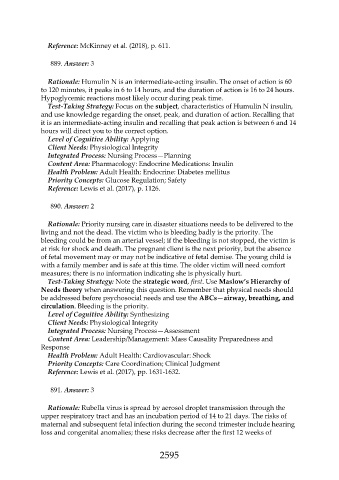Page 2595 - Saunders Comprehensive Review For NCLEX-RN
P. 2595
Reference: McKinney et al. (2018), p. 611.
889. Answer: 3
Rationale: Humulin N is an intermediate-acting insulin. The onset of action is 60
to 120 minutes, it peaks in 6 to 14 hours, and the duration of action is 16 to 24 hours.
Hypoglycemic reactions most likely occur during peak time.
Test-Taking Strategy: Focus on the subject, characteristics of Humulin N insulin,
and use knowledge regarding the onset, peak, and duration of action. Recalling that
it is an intermediate-acting insulin and recalling that peak action is between 6 and 14
hours will direct you to the correct option.
Level of Cognitive Ability: Applying
Client Needs: Physiological Integrity
Integrated Process: Nursing Process—Planning
Content Area: Pharmacology: Endocrine Medications: Insulin
Health Problem: Adult Health: Endocrine: Diabetes mellitus
Priority Concepts: Glucose Regulation; Safety
Reference: Lewis et al. (2017), p. 1126.
890. Answer: 2
Rationale: Priority nursing care in disaster situations needs to be delivered to the
living and not the dead. The victim who is bleeding badly is the priority. The
bleeding could be from an arterial vessel; if the bleeding is not stopped, the victim is
at risk for shock and death. The pregnant client is the next priority, but the absence
of fetal movement may or may not be indicative of fetal demise. The young child is
with a family member and is safe at this time. The older victim will need comfort
measures; there is no information indicating she is physically hurt.
Test-Taking Strategy: Note the strategic word, first. Use Maslow’s Hierarchy of
Needs theory when answering this question. Remember that physical needs should
be addressed before psychosocial needs and use the ABCs—airway, breathing, and
circulation. Bleeding is the priority.
Level of Cognitive Ability: Synthesizing
Client Needs: Physiological Integrity
Integrated Process: Nursing Process—Assessment
Content Area: Leadership/Management: Mass Causality Preparedness and
Response
Health Problem: Adult Health: Cardiovascular: Shock
Priority Concepts: Care Coordination; Clinical Judgment
Reference: Lewis et al. (2017), pp. 1631-1632.
891. Answer: 3
Rationale: Rubella virus is spread by aerosol droplet transmission through the
upper respiratory tract and has an incubation period of 14 to 21 days. The risks of
maternal and subsequent fetal infection during the second trimester include hearing
loss and congenital anomalies; these risks decrease after the first 12 weeks of
2595

